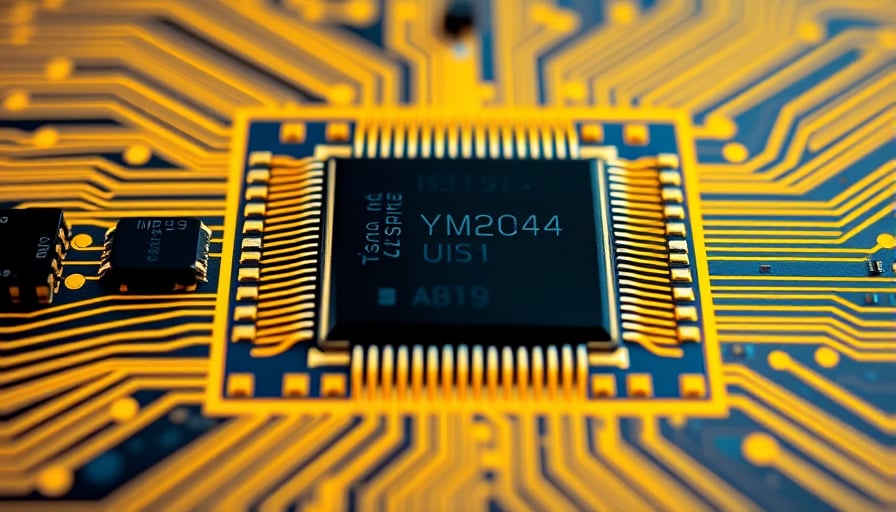Corporate News – Microchip Technology Inc. Advances AI Infrastructure with 3 nm PCIe Gen 6 Switch
Microchip Technology Inc. (NASDAQ: MCHP) has announced a significant leap forward in data‑center interconnect technology. The new 3 nm PCIe Gen 6 switch is engineered to meet the bandwidth and latency demands of next‑generation artificial intelligence (AI) workloads, cloud services, and hyperscale environments. The product supports up to 160 lanes at PCIe 6.0 speeds (up to 128 Gb/s per lane), incorporates low‑power and low‑latency features, and is designed for tight integration with silicon‑intelligence (Si‑Intelligence) accelerators.
Technical Highlights
| Feature | Specification | Business Impact |
|---|---|---|
| Process node | 3 nm FinFET | Enables higher density, lower power, and greater performance than 5 nm counterparts. |
| Lane count | 160 lanes | Provides aggregate bandwidth of ~20 Tb/s, supporting multi‑GPU clusters and large‑scale inference pipelines. |
| PCIe version | Gen 6 (6.0) | Double the peak data rate of Gen 5 (3.0), allowing seamless scaling of existing 5 nm infrastructure. |
| Power envelope | < 30 W per switch | Reduces data‑center energy consumption, improving TCO for hyperscale operators. |
| Latency | < 200 ns end‑to‑end | Critical for real‑time AI inference and edge computing workloads. |
The switch’s silicon‑intelligence architecture includes on‑chip memory buffers and programmable routing, enabling dynamic load balancing across accelerator tiles. This flexibility is especially valuable for workloads that fluctuate between compute‑intensive and memory‑bound phases, a common pattern in deep‑learning training and inference.
Market Context
Stock Performance
Microchip’s announcement coincided with a broader market rebound in the NASDAQ‑100 index. Following remarks by U.S. President Donald Trump on trade negotiations with China, the index recovered a significant portion of the Friday sell‑off, bolstering sentiment for technology equities. Although the VanEck Semiconductor ETF (tracking the MVIS US Listed Semiconductor 25) slipped 1.7% over the past five days, it remains up 34% year‑to‑date, reflecting sustained investor confidence in the sector’s growth trajectory.
Microchip’s stock closed at $64.60 on October 13, 2025. Over the past 52 weeks, the share price peaked at $79.44, while the company’s market capitalization sits at roughly $35.5 billion. The current price‑to‑earnings (P/E) ratio is negative, suggesting that earnings are either negative or highly volatile—an indicator that the market may be pricing in potential upside from the new switch, or conversely, that earnings have yet to fully reflect the product’s commercial potential.
Industry Trends
AI‑Driven Demand
Cloud providers and hyperscale operators are investing heavily in AI accelerators, driving a need for high‑bandwidth, low‑latency interconnects. PCIe 6.0’s 128 Gb/s per lane offers a critical bandwidth ceiling for scaling GPU clusters and silicon‑intelligence nodes.Process Node Consolidation
While 5 nm is the dominant node for most mainstream CPUs, the 3 nm technology offers marginal gains in power and density. Microchip’s early entry into 3 nm interconnects positions it ahead of competitors that are still lagging behind in process adoption.Ecosystem Compatibility
The switch is designed to work seamlessly with existing PCIe 5.0 infrastructure, allowing incremental upgrades rather than wholesale replacements—an attractive proposition for operators seeking a lower capital expenditure (CAPEX) pathway.
Expert Perspectives
Dr. Elena Park, Lead Analyst at Semiconductor Insights:
“Microchip’s 3 nm switch is a game‑changer for AI workloads that require tight coupling between compute and memory. The ability to support 160 lanes at Gen 6 speeds means that hyperscale data centers can consolidate more accelerators per interconnect, reducing overall footprint.”Raj Patel, CTO of CloudEdge Solutions:
“From a deployment standpoint, the switch’s low‑latency and programmable routing are invaluable. We’re particularly interested in how the silicon‑intelligence features will handle dynamic workload migration, which is a pain point in our current multi‑tenant environment.”Lisa Cheng, Portfolio Manager at Vanguard Semiconductor ETF:
“While the ETF has dipped slightly, the sector’s long‑term trajectory remains robust. Microchip’s negative P/E is not uncommon in a technology space where capital is heavily reinvested. The new switch could catalyze a shift in the competitive landscape, potentially unlocking upside for investors.”
Actionable Takeaways for IT Decision‑Makers
Assess Bandwidth Requirements
Evaluate whether current AI workloads are approaching the PCIe 5.0 bandwidth ceiling. If so, planning a phased migration to Gen 6 could deliver performance gains without a full infrastructure overhaul.Consider Power and Cooling Budgets
The switch’s sub‑30 W power envelope can lower cooling costs—an important metric for hyperscale facilities where data‑center energy cost accounts for 30–40% of total operating expenses.Review Vendor Relationships
Early adoption of 3 nm interconnects may require new supply‑chain arrangements. Engage with Microchip to understand lead times, volume discounts, and firmware support schedules.Monitor Earnings and Valuation
The negative P/E ratio signals that the market has not yet fully priced the product’s future cash flows. Keep an eye on earnings reports following the product launch to gauge commercial traction.Leverage Programmatic Routing
The silicon‑intelligence capability can simplify dynamic workload distribution. Evaluate integration with existing orchestration platforms to maximize return on investment.
Conclusion
Microchip Technology Inc.’s launch of a 3 nm PCIe Gen 6 switch marks a pivotal moment for the semiconductor industry, especially for enterprises reliant on AI and cloud services. By combining cutting‑edge process technology with a high‑lane count and low‑latency design, the company offers a scalable solution that can meet the evolving demands of hyperscale data centers. For IT leaders, the announcement presents both an opportunity to boost performance and a strategic consideration in terms of investment timing and infrastructure planning.
